Answer these simple questions and we will find you the BEST prices
Which type of solar quotes do you need?
It only takes 30 seconds
100% free with no obligation

Get Free quotes from loft conversion specialists near you

Save money by comparing quotes and choosing the most competitive offer

The service is 100% free and with no obligation
- GreenMatch
- Loft Conversion
- Air Conditioning for Loft Conversion
Air Conditioning for Loft Conversion: Is It Really Needed?

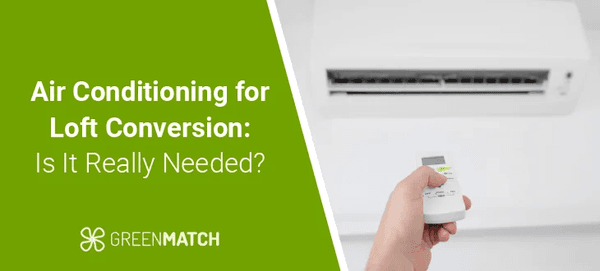
- A typical AC unit uses between 0.5 to 2 kWh per hour, depending on its size and efficiency.
- Running an AC for 8 hours a day can add around £1.36 to £4.08 per day to your electricity bill, depending on the unit's efficiency.
- More sustainable options include air-source heat pumps, ceiling fans, and proper insulation, which reduce the need for heavy cooling.
The loft space often gets warmer than other parts of the house, making temperature control a concern, especially during summer.
You might wonder if loft conversion air conditioning is worth the investment, how much it will increase energy bills, and whether it's a sustainable option.
This guide will help you weigh the pros and cons, explore more sustainable alternatives, and decide if air conditioning is the right solution for your loft conversion.
Ready to get started on your loft conversion? Stop wasting time searching for installers—simply fill out this quick form to receive up to 3 quotes from trusted local professionals. Click below to get started!
- Describe your needs
- Get free quotes
- Choose the best offer
It only takes 30 seconds



Do you need air conditioning for a loft conversion?
Air conditioning is generally not essential for loft conversions in the UK, but it can be beneficial depending on how you plan to use the space. Loft rooms tend to heat up in the summer as warm air rises, making them uncomfortable on particularly hot days. However, since the UK only experiences a handful of truly hot days each year, cooling isn’t needed for most of the year.
Modern air conditioning units often come with built-in heating functions, making them a more versatile option if you’re concerned about temperature control throughout the year. That said, if you plan to use the loft as a year-round living space, air conditioning can serve a dual purpose by providing both cooling in the summer and heating during colder months.
Ultimately, installing air conditioning in your loft conversion depends on your personal preferences and how you plan to use the space. It’s an investment that may offer convenience, but it’s not a strict requirement for most UK homes.
Benefits of installing air conditioning
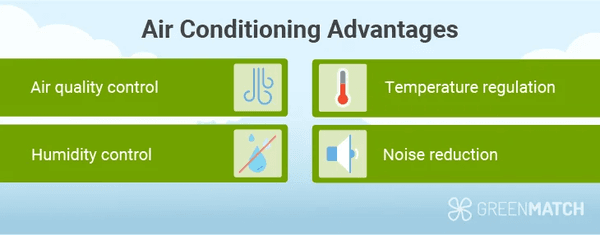
Installing air conditioning in your loft conversion offers several benefits:
- Air quality control: AC units help filter out dust, allergens, and other pollutants, improving the overall air quality of the space.
- Humidity control: By reducing moisture in the air, air conditioning prevents dampness and mould growth, which is particularly important in loft spaces with limited ventilation.
- Temperature regulation: AC systems provide consistent cooling in the summer and, with modern units, heating during colder months, ensuring year-round comfort.
- Noise reduction: Many air conditioning units operate quietly, reducing the need to open windows and allowing you to enjoy a peaceful environment without external noise intrusion.
Loft air conditioning cost
For a basic, low-end unit, you can expect to pay around £500–£1,000, while more advanced, high-end systems can range from £2,000–£4,000 or more. The cost of installing air conditioning in loft conversion itself may add another £1,000–£2,500, depending on the complexity.
In addition to upfront costs, you'll need to consider running and energy costs. A standard air conditioning unit for loft conversion consumes about 1–3 kWh of electricity per hour, depending on the model.
Based on the current UK average electricity price of 34p per kWh, here's a breakdown of the estimated running costs:
| Average costs | Split AC | Ducted AC |
|---|---|---|
| Cost per hour | £0.117p | £1.22p |
| Cost per day (24 hours) | £2.808 | £29.28 |
| Cost per week (7 days) | £19.656 | £204.96 |
| Cost per month (30 days) | £78.62 | £819.84 |
These running costs can vary based on usage, but it’s essential to consider energy-efficient models to reduce overall expenses.
Modern air conditioning units are built with advanced technologies like inverter compressors, which adjust the speed of the compressor motor to match the cooling demand, leading to significant energy savings.
Additionally, units with a high SEER (Seasonal Energy Efficiency Ratio) rating are designed to maximise energy efficiency while delivering effective cooling and heating.
Instead of running at full power continuously, these models monitor room conditions and adjust accordingly to maintain comfort with minimal energy use. In fact, energy-efficient air conditioning units can reduce electricity consumption by up to 30–40% compared to older models.
By choosing an energy-efficient unit, you not only save on electricity bills but also contribute to reducing overall energy consumption, making the cooling process more sustainable in the long run.
To ensure you choose the best air conditioning in loft conversion, it's essential to seek guidance from experts in loft conversions. These specialists can evaluate your specific needs and the unique characteristics of your home to recommend the most efficient and effective solutions.
For example, if you have a mezzanine loft conversion, the additional load of the mezzanine floor itself may limit the types of AC systems you can install, especially if heavy ductwork is involved.
Consulting with a professional will help you navigate these considerations and ensure that your air conditioning choice integrates seamlessly with your loft's structural and aesthetic requirements, enhancing comfort and efficiency.
To guarantee you get the best value and service, consider gathering multiple quotes from various professionals.
Take the first step towards a cooler, more comfortable home today. Use this quick and easy form to request up to 3 quotes from local installers and start planning your conversion today!
Click below to begin!
- Describe your needs
- Get free quotes
- Choose the best offer
It only takes 30 seconds



How sustainable is air conditioning for a loft conversion?
Air conditioning units, particularly traditional ones, can consume significant amounts of energy, contributing to higher carbon emissions.
The energy consumption of an AC unit depends on its size and efficiency. For example, a 1-ton unit can use between 0.48 kWh to 0.86 kWh per hour, depending on its SEER rating (Seasonal Energy Efficiency Ratio).
This means that running such a unit for 8 hours could consume 3.84 kWh to 6.88 kWh, translating to a notable energy impact over time.
When considering sustainability, newer models offer better energy efficiency. For example, portable air conditioners, which can be more sustainable due to their lower energy consumption, may only use around 0.99 kWh per hour. This would cost roughly £0.24 per hour to run.
Modern AC systems often come with ECO modes and energy-saving features, reducing their environmental impact compared to older models.
Here is the table illustrating the average energy consumption by air conditioners:
| AC Size | Hourly consumption (kWh) | Daily consumption (24h, kWh) |
|---|---|---|
| 1-ton AC | 0.48–0.86 | 11.5–20.6 |
| 2-ton AC | 0.96–1.71 | 23.0–41.0 |
| Portable AC | 0.99 | 5.82 |
Keep in mind that choosing an energy-efficient model and minimising usage, especially during cooler periods, can help reduce the environmental impact of air conditioning in your loft conversion.
Sustainable alternatives to air conditioning for loft conversions
If you're looking for eco-friendly ways to cool your loft conversion, several sustainable alternatives to air conditioning can be just as effective while reducing energy consumption.
Air source heat pumps
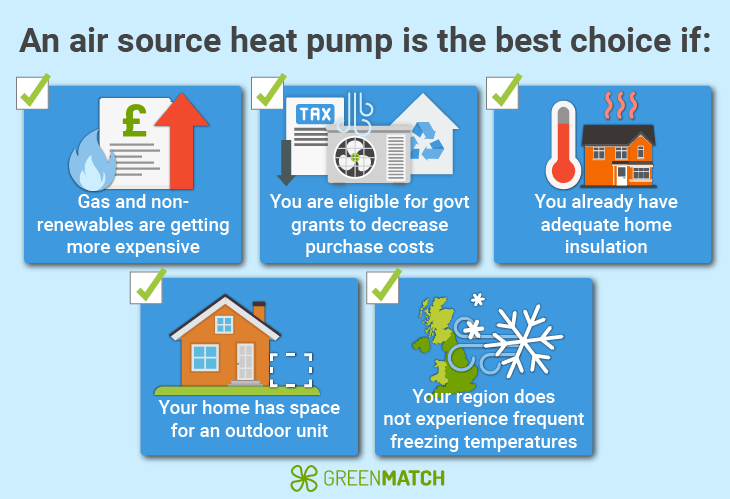
Air source heat pumps are highly efficient because they transfer heat rather than generating it. In summer, they work like air conditioners, drawing heat out of your loft, while in winter, they reverse the process to heat the space.
For loft conversions, they can be an excellent all-in-one solution, using 30–50% less energy than traditional electric heating and cooling systems.
Installation costs can range between £6,000–£12,000, but the long-term energy savings and government incentives, such as the Renewable Heat Incentive (RHI), can help offset this cost.
Solar panels
Solar panels can make running an air conditioner more sustainable by generating the energy needed from sunlight.
A typical 4kW solar panel system, which costs between £5,000–£7,000, can produce around 3,400 kWh of electricity annually—enough to cover most of a home’s cooling needs during sunny months.
Pairing solar panels with battery storage allows you to store excess energy for night-time use, further reducing reliance on the grid and increasing energy efficiency in your loft conversion.
Proper insulation
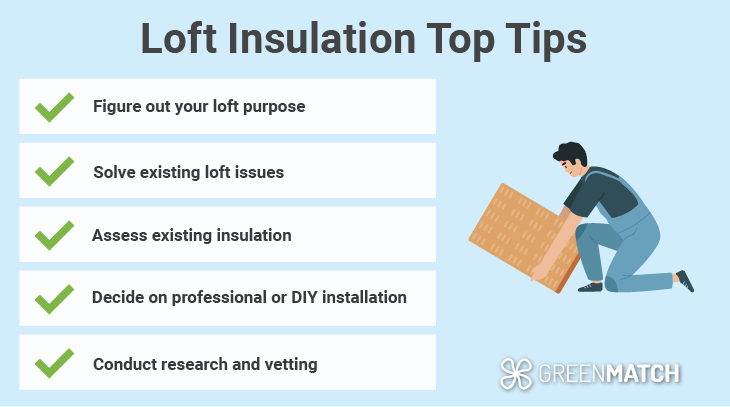
High-quality insulation is crucial for maintaining a stable temperature in your loft. Rigid foam insulation or spray foam insulation are ideal for loft spaces as they create an airtight seal, preventing heat from escaping in winter and blocking heat from entering in summer.
Insulating your loft can reduce energy bills by up to 25% and minimise the need for air con for a loft conversion. For the best thermal performance, it’s also important to insulate walls, floors, and around skylights.
Modern energy-efficient air conditioners
If you opt for aircon for loft conversion, choose units with a high SEER (Seasonal Energy Efficiency Ratio) rating—at least 16 SEER for energy-efficient performance. Look for models with inverter technology, which adjusts the compressor speed to save energy.
Smart AC units can also be programmed to run only when needed, minimising unnecessary energy consumption.
Energy-efficient units can reduce electricity usage by up to 40% compared to older models, offering substantial long-term savings.
Ceiling fans
Ceiling fans are a cost-effective way to maintain air circulation, using only 10–15 watts of energy per hour, compared to 500–2,000 watts for air conditioners.
When paired with proper ventilation, they can reduce the perceived temperature by 3–4°C, making the loft feel cooler without the need for AC.
They are also much cheaper to install, with most units costing between £50–£300, depending on the size and features.
Shading solutions
Shading solutions are a highly effective and eco-friendly way to manage heat gain in any loft conversion. By using external features like awnings, deep overhangs, or planted green walls, you can prevent excessive sunlight from entering the interior and reduce the need for mechanical cooling.
These systems block the sun's rays before they hit the windows and walls, significantly lowering the temperature inside. In addition, strategically placing deciduous trees around your home provides seasonal benefits—offering ample shade during the summer while allowing sunlight to pass through in the winter when the leaves have fallen.
Shading solutions are particularly beneficial for a master suite loft conversion. Given that the master suite is often designed as a luxury, retreat-like space, maintaining a comfortable and serene environment is crucial.
Shaded options like green walls not only provide a cooling effect but also enhance privacy and contribute to a more tranquil, natural atmosphere—perfect for a master suite.
Opening windows
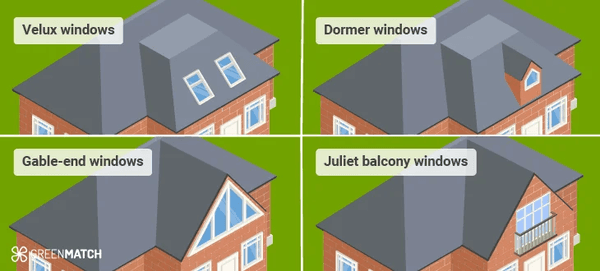
Maximising natural ventilation is one of the simplest ways to cool your loft. Installing vented skylights or roof windows can increase airflow, allowing hot air to escape while bringing in cooler outdoor air.
Windows with double glazing help keep heat out during the summer and maintain warmth in winter. By opening windows during cooler parts of the day, such as early morning or late evening, you can significantly reduce the need for mechanical cooling.
Incorporating a balcony in your loft conversion can further enhance natural ventilation. Loft conversion with a balcony not only provides a refreshing outdoor extension to your living space but also facilitates increased cross-ventilation.
This setup draws in fresh air and expels hot air more efficiently, making it an excellent feature for sustainable cooling.
For more tailored advice and professional recommendations, consider getting multiple quotes for loft conversion to find the best sustainable solution for your loft conversion needs.
Streamline your loft conversion planning with this quick and easy form! Request up to 3 quotes from local installers in just minutes and take the first step towards your dream space today! Click below to get started!
- Describe your needs
- Get free quotes
- Choose the best offer
It only takes 30 seconds



FAQ
Air conditioning isn’t always necessary, but it can help during hot days. Good insulation and ventilation can often keep the space cool without AC.
Yes, you can install AC in a loft, with mini-split systems being a popular choice as they’re efficient and don’t need ductwork.
Use insulation, open windows for ventilation, install ceiling fans, or consider energy-efficient AC units for extra cooling.

Tania is an experienced writer who is passionate about addressing environmental issues through her work. Her writing aims to shed light on critical environmental challenges and advocate for sustainable solutions.
We strive to connect our customers with the right product and supplier. Would you like to be part of GreenMatch?

